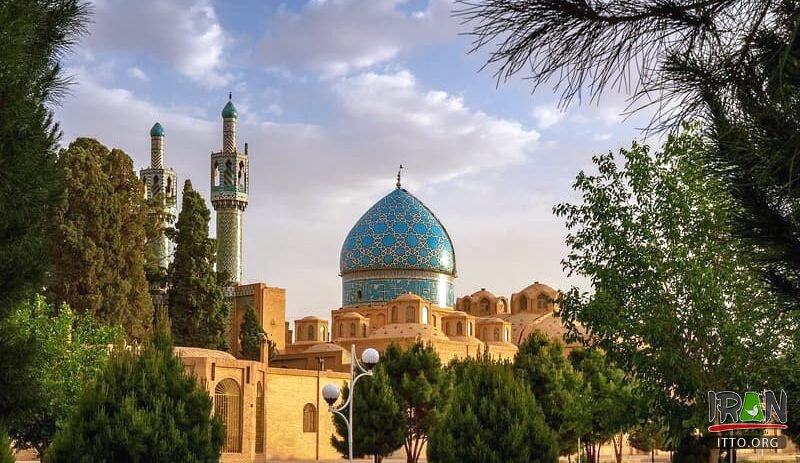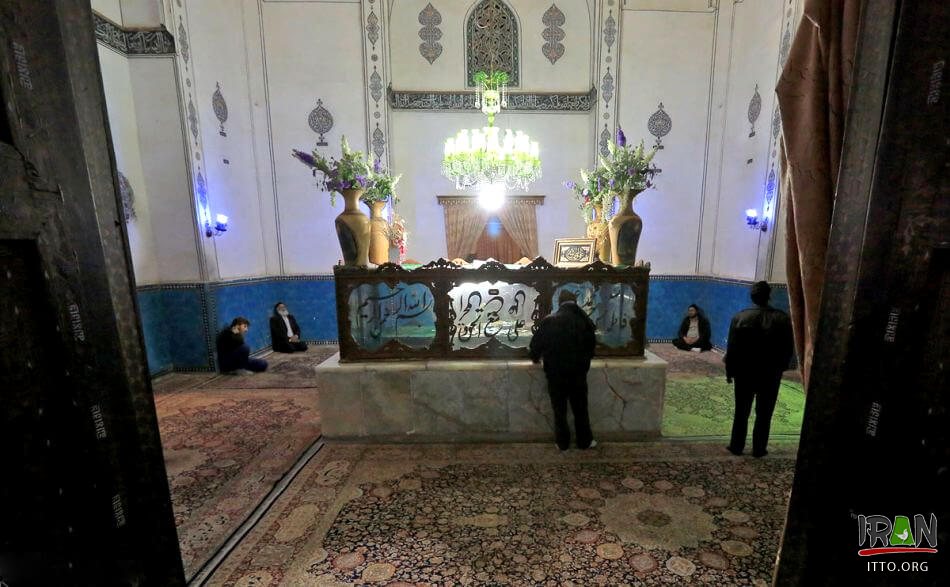Shah Nematollah-e Vali (Shaah Nimatullah Wali) was the head of the Ellahiyeh (Elahieh) (730-834 AH.), and was one of the reputed Gnostics of the first half of the 9th century AH. He was a Persian Sufi Master and poet from the 14th and 15th centuries. He is revered by Sunni as a saint and by the Sufi order Nimatullahi who consider him their founder. His tomb and Khaneqah (or a kind of monastery) is located in the town of Mahan (Kerman).
The Hezar Shah structure is the axis of this aggregate, and its primary construction dates back to the year 840 AH. Ahmad Shah Bahmani (of the Bahmaniyeh Dynasty) was responsible for the expenditure.
Sections were added to this in later periods. The Vakil-ol-Molk court-yard is opposite this mausoleum, and was constructed in the Qajar era. The structure displays a Mongol type of architecture (of the Eilkhani and pre-Safavid periods) and its porch pertains to the Esfahani mode of architecture, and is one of the wonderful pieces of art works in desert area of Iran.
The complex includes some courtyards and other sections which are as follows when one moves from the street toward the interior of the mosque: Atabaki courtyard, Vakil-ol-Molki courtyard, Modir-ol-Molki portico, the shrine, Shah Abbasi portico, Mirdamad courtyard and Hosseiniyeh courtyard.

During the Qajar period the site was particularly popular, necessitating the construction of additional courtyards to accommodate increased numbers of pilgrims.
has been built through contributions from Ali Asghar Khan Atabak, the chancellor of Naser al-Din Shah and has porticos around and a big pond in the middle.
Vakil-ol-Molki courtyard:
Vakil-ol-Molki courtyard has been built by Mohammad Esmaeil Ebrahim Khan Nouri, Vakil-ol-Molk. On the upper part of the entrance corridor is Shah Nematollah Museum while a bookshop is located to the north and the tombs of Amir Nezam Garousi, the famous politicians, literary experts, artist and renowned figure of Qajar area are located to the southwest. There is a polygonal pond in the middle of the courtyard, which is usually adorned with geraniums. After Mohammad Esmaeil Khan died, his son, Morteza Qoli Khan, added two minarets and a portico to the complex.
Shrine of Shah Nematollah Vali (Zarih of Shah Nematollah Vali) :
It has a dome-shaped arch which is adorned with paintings and has two shells. In the middle of the arch, there is a Zarih which is 3.4 m long and 2 m wide. On the marble stone which is the last covering of the tomb, there is a Quranic verse around which the names of 12 Shia Imams have been written.

In Tomb Room there is a Quranic verse around which the names of 12 Shia Imams have been written
On the southwestern side of the portico behind the shrine, there is a small place where Shah Nematollah Vali spent 40 days and nights worshipping God. Its roof is like the hat worn by Sufis and has 12 cracks in it. Some verses of the Quran and Persian poems have been written on the walls. Chelleh Khaneh was totally damaged during a flood in 1932, but was reconstructed later.
Shah Abbasi Portico:
The portico has been built in 998 AH under the rule of Shah Abbas I and when Beik Tash Khan was the ruler of Kerman. The names of 12 Shiite imams have been written at the entrance of the portico in relief inscription.
Mirdamad Courtyard:
This courtyard which is also known as Shah Abbasi courtyard has been reconstructed under the rule of Naser al-Din Shah of Qajar dynasty.
Hosseiniyeh Courtyard:
This is the last courtyard of Shah Nematollah Vali complex which contains the Mohammad Shahi minarets standing on the western side of it. The minarets are 42 m high and were built under the rule of Mohammad Shah Qajar. They were damaged in an earthquake in 1981. This courtyard is connected to Biglarbeigi House by a bridge, which is currently known as Motevalli Bashi House and is a hostel. The bridge was destroyed in a flood in 1932. Other parts of the shrine include the library and Shah Vali Museum where valuable copies of the Quran, one of which is attributed to Bibi Khatoun and is called Si-Pareh (30 pieces), various types of armors and swords and a unique piece of cloth which once covered the tomb are being kept. The fabric is among artistic handicrafts of Kerman province, which is called Pateh and was built under Naser al-Din Shah for four years by tens of Kermani artists.

